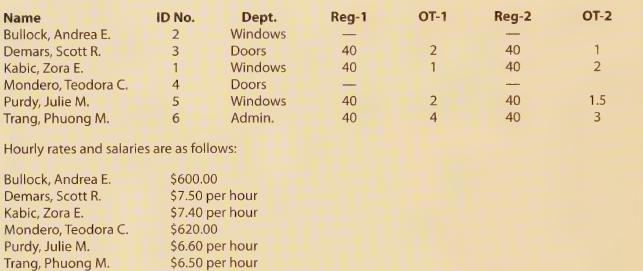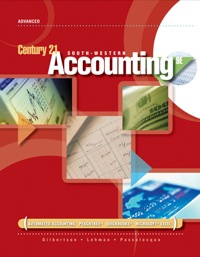ColdGuard has two departments, Windows and Doors. It uses a biweekly payroll system of 26 pay periods
Question:
ColdGuard has two departments, Windows and Doors. It uses a biweekly payroll system of 26 pay periods per year. ColdGuard pays salesclerks and employees in the accounting department on an hourly basis, and they receive 1% times the regular hourly pay rate for all hours worked in excess of 40 hours in one week. The hours worked report shows the following information.

Department supervisors receive a biweekly salary and monthly commissions of 1% of net sales. Commissions for the previous month are paid in the first pay period of the next month.
ColdGuard’s partially completed payroll records for selected employees for the pay period ended March 14 and paid on March 21 of the current year are provided in the Working Papers.
Instructions:
1. Complete the commissions record for each departmental supervisor. The following data are from the accounting records for the month of February of the current year:
a. Windows Department: sales on account, \($5,543.89;\) cash and credit card sales, \($8,047.02;\) sales discount, \($92.01;\) sales returns and allowances, \($285.40.\)
b. Doors Department: sales on account, \($5,312.32;\) cash and credit card sales, \($9,409.85;\) sales discount, \($148.63;\) sales returns and allowances, \($1,478.21.\)
2. Use the time records and completed commissions records to complete the payroll register for the pay period ended March 14 and paid March 21 of the current year. Use the following additional data to complete the payroll register:
a. A deduction for federal income tax is to be made from each employee's total earnings. Use the appropriate income tax withholding tables shown in Lesson 3-1 in this chapter.
b. A deduction of 3% for state income tax is to be made from each employee's total earnings.
c. Deduction of 6.2% for social security tax and 1.45% for Medicare tax are to be made from each employee’s total earnings.
d. All employees have medical insurance, \($14.80,\) and dental insurance, \($8.20,\) deducted from their pay each biweekly pay period. Use M to indicate the medical insurance deduction. Use D to indicate the dental insurance deduction.
3. Complete the employee earnings record for each employee. This pay period is the fifth of the first quarter of the current year.
4. Journalize the March 21 payroll payment on page 5 of a cash payments journal. The source document is Check No. 211.
5. Use a grid similar to the one in this chapter to calculate departmental payroll taxes. You will need only one taxable earnings column, since no employee's accumulated earnings are greater than the base for unemployment tax. Employer tax rates are social security, 6.2%; Medicare, 1.45%; federal unemployment, 0.8%; and state unemployment, 5.4%.
6. Journalize the employer payroll taxes on page 7 of a general journal. Use March 21 of the current year as the date. The source document is Memorandum No. 33.
Step by Step Answer:






